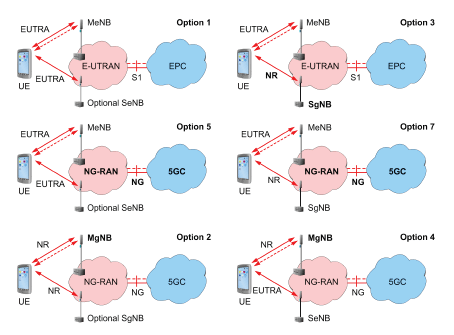Architectural Options for 5G
- , by Paul Waite
- 2 min reading time

Many of the benefits of 5G, such as low user plane latency, high data rate and support of high radio frequencies, can be achieved simply by transmitting data over the 5G New Radio. Furthermore, there are market pressures on network operators for an early roll-out of 5G networks in which those benefits are delivered to the user. To reflect these issues, 5G is designed to support an evolutionary roll-out in which operators can gradually introduce the capabilities of 5G into their networks, without the immediate need for wide-area 5G coverage. This is achieved using a number of different architectural options, which are identified using a scheme that was introduced as part of the early 5G study reports, and which are shown in the diagram.
Option 1 is the legacy dual connectivity architecture from LTE Release 12. The mobile is controlled by a master eNB (MeNB), which delivers data packets to and from the user, and delivers signalling messages that control the UE’s operation. Optionally, the mobile can also communicate with a secondary eNB (SeNB), which handles mainly traffic (as well as limited signalling, not shown in the diagram). In option 3, the secondary eNB is replaced by a secondary gNB (SgNB). This allows network operators to offer the high data rates supported by the 5G New Radio, without the need for wide-area 5G coverage.
Options 5 and 7 introduce the 5G Core Network (5GC) and the Next Generation Radio Access Network (NG-RAN). These include new network functions and interfaces, and support new capabilities such as network function virtualisation, software defined networking and network slicing. The mobile is still controlled by a master eNB, with an optional secondary eNB in option 5, and with a secondary gNB in option 7.
In options 2 and 4, the gNB takes on the role of the master gNB, with an optional secondary gNB in option 2, and with a secondary eNB in option 4. By using these options, the operator can roll out 5G into parts of the network without any prior LTE coverage.
These options can co-exist within a single operator’s network. In particular, the E-UTRAN and EPC can coexist with the NG-RAN and 5GC, with the 3GPP specifications providing support for inter-operation. Options 3 and 7 are known as Non Standalone (NSA) implementations of the 5G New Radio, because the gNB cannot operate on its own. In contrast, options 2 and 4 are Standalone (SA) implementation of 5G. Generically, a master eNB or gNB is known as a master node (MN), and a secondary eNB or gNB is known as a secondary node (SN).













